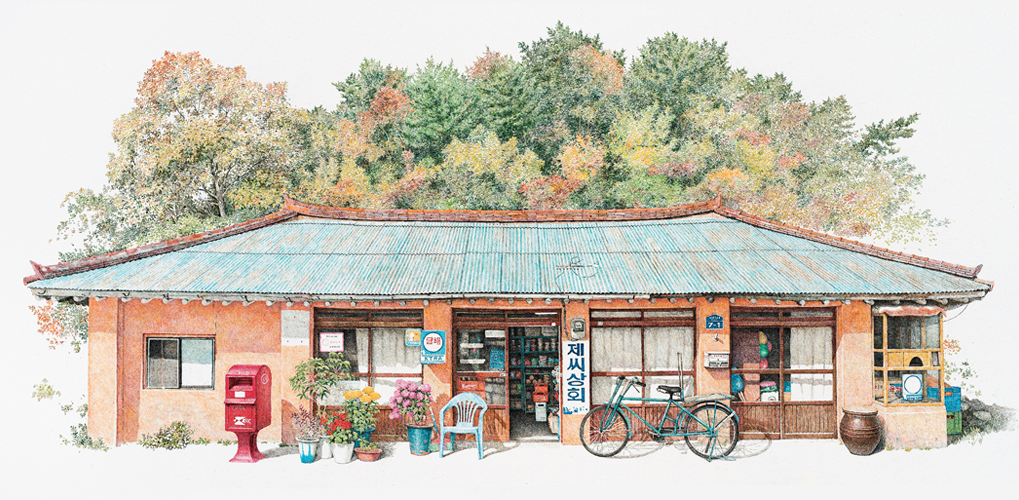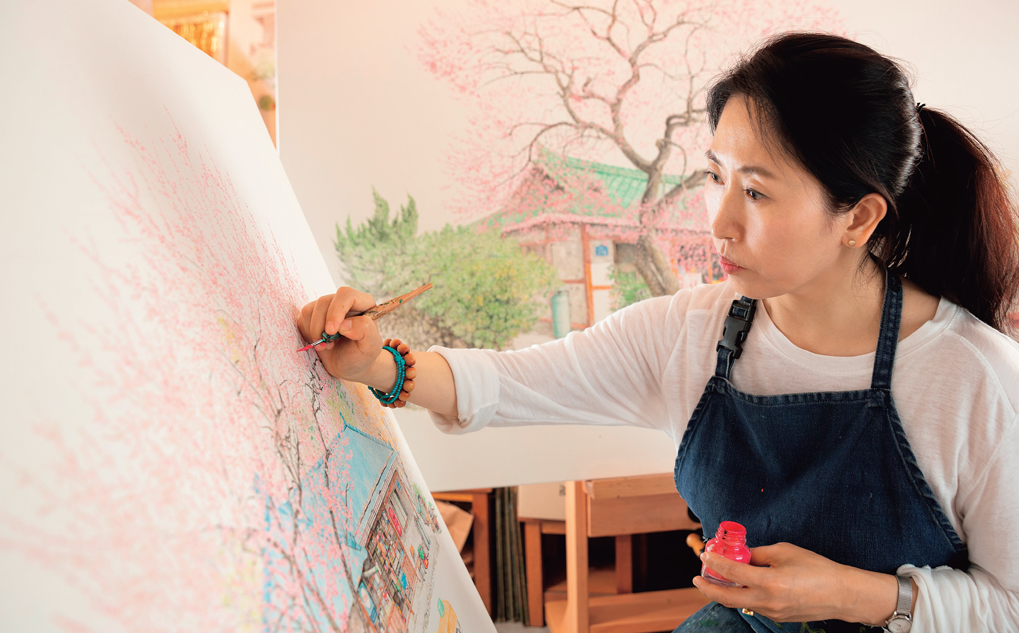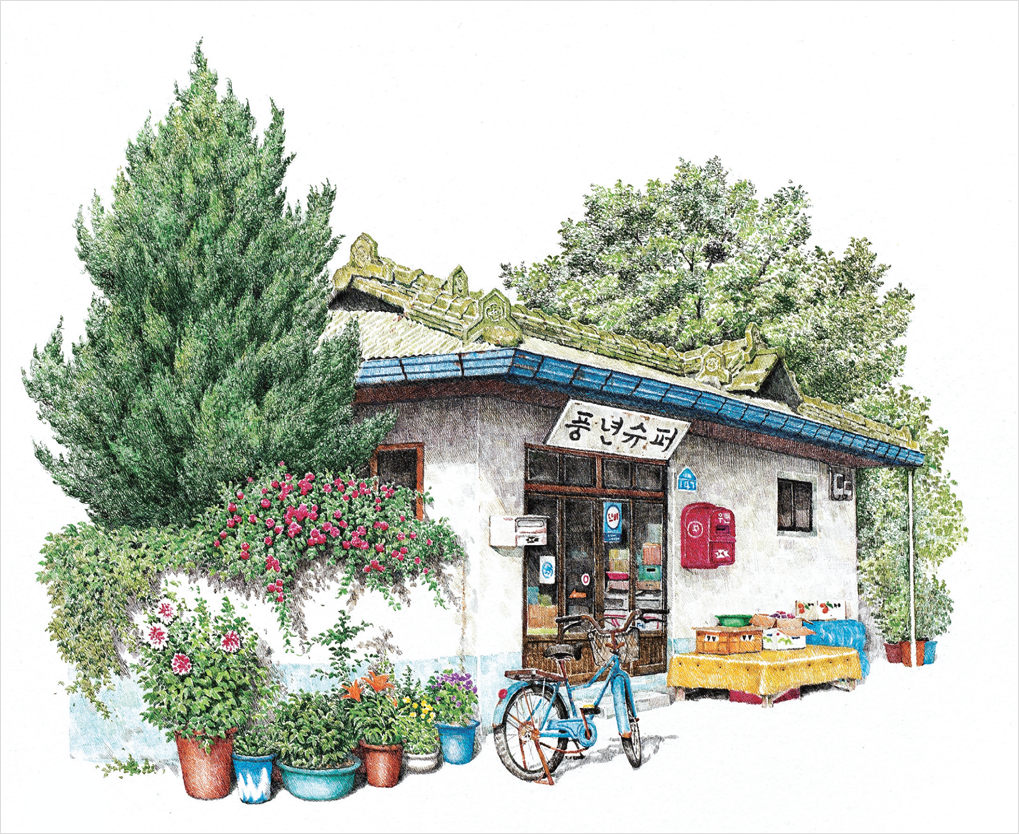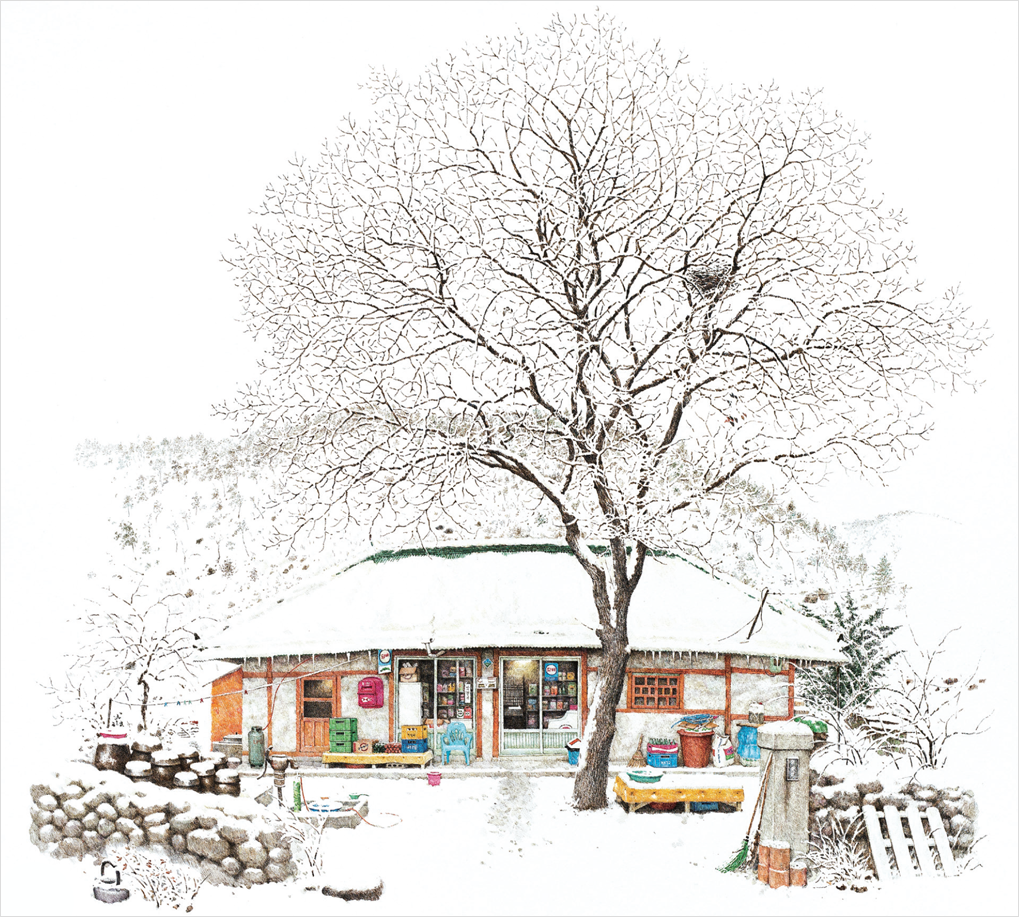Lee Me-Kyeoung is enthralled by things that are fading away. For the past 20 years, she has traveled all over the country in search of old corner stores that have become symbolic places of decline and extinction. With fine, delicate pen strokes, she captures the age-old stories of the charming mom-and-pop stores and the people who have spent their lives around them.

“Je Family Store” (2018). Pen and acrylic ink on paper, 75 × 135.5 cm.
Lee Me-Kyeoung has a little bump on the side of her right middle finger, a reminder of her years spent holding a pen more than 10 hours a day and drawing thousands, or even tens of thousands of lines. Every morning, when she steps into her atelier, she becomes a “laborer” with the pen as her tool. Whish, whoosh the sound of the nib passing over the paper invigorates her. Her days flow in harmony with the repetitive strokes of her pen.
“You can’tpen and ink drawings with a half-hearted effort,” said Lee. “Brushstrokes cannot compare with the texture d by the multiple s of ultra-thin, delicate pen lines. I combine 28 acrylic ink colors and draw as if I’m ing the different colors. This way, the color underneath emerges brightly and clearly. The colors become solid without appearing too thick, much like the unaffected charm of the corner stores weathered and worn by the times. So, in a way, the subject matter and form are in perfect harmony.”
Lee studied Western painting at Hongik University when German Neo-ism was the dominant trend in the art world. There were days when she stayed all night at the school’s art room; one of those nights, she produced four large paintings. It was by chance that she switched to pen and ink painting, an art form which calls for meticulous detail. In summer 1997, she was pregnant with her second child while raising a baby just over two years old when she left Seoul to live in the nearby city of Gwangju, Gyeonggi Province. It was there that she saw the corner store that seemed to have been waiting for her all along.
Subject for Life’s Work
“The first spring after I had my second child, I was spending my days sitting in front of the canvas again with a pen, drawing random things that came to mind, searching for a new beginning,” Lee recalled. “One beautiful day when cherry blossom petals were falling like snow, I made a trip to the corner store. I hadn’t been there in a long while, and the place seemed unfamiliar and at the same time quaintly charming. The reddish-brown slate roof displayed subtle changes in color depending on the time of day, and even the word ‘beverages’ in red letters written on the window in a slapdash manner seemed stylish.”
She returned home and waited until her children were asleep before she started drawing. She was elated, her heart fluttering with excitement; emotions she hadn’t felt in a long time. The constant pressure of having to draw something had weighed heavily on her, and suddenly she felt liberated from the distress and anxiety. She had finally found the subject that tugged at her hearts - that would be her life’s work. “That’s it. This is what art is,” she realized. She slowly and patiently waited for that “perfect” store that would captivate her heart. This is why during the first 10 years she managed to produce no more than 15 pieces.
Whenever she hears of a corner store that still retains its authentic old charm, she immediately goes to see it. Once is not enough. She wishes to fully capture the store’s charm as it changes between night and day, and from season to season. Even though she takes dozens of photographs, there is always a detail that she misses. There is a huge difference between simply observing the store with your eyes and cherishing it in your heart. As word has spread that she draws small neighborhood stores, many people have come to her with information about a mom-and-pop store somewhere. A few years ago, she received a text message from an acquaintance that said, “Ms. Lee, Yusim Store in our neighborhood is closing down soon. You should come quickly and take pictures if you haven’t already done so.”

Tothe texture of a pen and ink drawing, thousands, or even tens of thousands of fine pen lines are ed on top of each other. Lee Me-kyeoung spends more than 10 hours a day working on her drawings, causing chronic pain in her right middle finger.
“I want to share the stories tucked away in my memory with others and reminisce together.”
“I had been to the store a couple of times and knew the owner, an old lady over 80,” Lee recollected. “I thought she had finally decided to close the business after running it for over 50 years. It was so sad to think yet another old store in Seoul would fade into history. I felt a part of me crumble inside.”
There have been stores that were damaged, changed, or replaced by a new establishment even before she finished her drawing. She oftentimes would go to a store she had heard about, only to find it had already closed down. Lamenting the demise of the small neighborhood stores, Lee said, “It is sad to think how much we are sacrificing in the name of growth and development.”

“Pungnyeon Supermarket” (2017). Pen and acrylic ink on paper, 35 × 35 cm.
“Looking at the collection of my corner store drawings produced over the past 20 years, I see how the structure of the buildings, the shape of the roof and materials vary by region,” said Lee. “When I come across an old store, I have the habit of picturing what it would have looked like when it first opened. For example, slate roofs were introduced in the early 1970s as a result of the Saemaul (New Community) Movement. I have even come across Japanese-style wooden houses with high roofs that were built during the Japanese rule. It would be interesting just to compare the different roofs in my drawings. They suggest the importance of preserving and restoring the past and putting a check on the rampant practice of doing away with the old and replacing it with the new.”
The quaint little stores and their owners - the discoveries of her nationwide search - continue to live on in her drawings. Since no one knows if or when they will return, her slowly and scrupulously d artworks are, in effect, an archive that bears testimony to the times.
Memories for Everyone
“Some people ask why I’m fixated on things that are disappearing from our lives, why I’m wrapped up in nostalgia,” said Lee. “But I want to share the stories tucked away in my memory with others and reminisce together. All I’m suggesting is that we be more aware of what is around us and not miss the opportunity to appreciate the small, simple things that have been a part of our lives. A friendly neighborhood store, a mother’s warm embrace, sewing baskets, old dishes - I want to depict in my drawings those things that evoke tender feelings and tell common stories of ordinary lives.”
Corner stores are not simply a plain building to Lee. They each have their own character, just like people. She still remembers a nameless store she happened upon when she visited Ttangkkeut (“land’s end”) Village in Haenam at the southernmost point of the Korean peninsula. “I was climbing an uphill road next to Mireuk Temple along Highway 806 when I spotted the store. I could tell at a glance that it was a place with a long history, appearing as though it had witnessed the many joys and sorrows of the times,” she recalled.
Sitting desolately under the dusky evening sky, the store embodied the images of all the corner stores Lee had searched for across the country and ed. As darkness began to descend and the sky turned a deep purplish blue, the dense trees standing at the back emerged like a folding screen revealing their stately presence, and the store unveiled its true character.

“Winter in Sancheok” (2017). Pen and acrylic ink on paper, 80 × 80 cm.
“The glow of the streetlamp standing next to the store and the yellowish light flowing out through the windows appeared like the bright eyes of a saint radiating warmth. There was a poignant beauty about the mysterious atmosphere d by the shadows of the night and the glowing lamplight that is particular to old rundown shops. It was the epitome of the motif of my works,” said Lee.
Lee’s corner store drawings invariably include a tree. She depicts them in various forms and shapes depending on the region and season, so that they are in harmony with the subject matter. Just as every person has a family, a corner store needs to have at least one tree, she thinks. Time stands still in her drawings, but the trees continue to grow. The older the shop, the larger the tree, standing next to each other like good friends.
“Ten years ago I visited Seokchi Store in Gunsan, North Jeolla Province. It was the archetype of corner stores and looked as if it might have leapt out of one of my drawings,” said Lee. “There were two large trees standing on the left side of the store that d an odd harmony. With the appearance of a Taoist immortal, the gray-haired shopkeeper told me the story of his 40 years with the store. There was something deeply moving about a person’s lifelong dedication to a single pursuit. Later I heard that the store closed a few years after my visit. Only the two chestnut trees remained standing. Like family, they will remember the store and its owner, and pass along their stories.”
A Slow, Full Life
In March 2017, BBC News introduced 10 works by Lee in an article titled “The Charm of South Korea’s Disappearing Convenience Stores.” She was also invited to exhibit her works at the Tokyo International Art Fair this May. Lee’s heartwarming drawings of mom-and-pop stores - originally intended for domestic audiences - have garnered the attention of global art dealers and art lovers. Her book titled “Fond Childhood Memories of the Corner Store,” which features 80 of her drawings and the stories behind them, has been immensely popular. It was published in France and Taiwan in June and a Japanese translation is on its way. Lee’s solo exhibition is slated for October in Seoul.
“Exhibitions are by no means easy because the drawings take so much time and work. It requires stamina and energy, which is why I have to pace myself and take care of my health. I intend to take it easy next year and relax a little,” she said.
In the meanwhile, she has a lot of work on her hands. She hopes to organize her 200 or so corner store drawings that are scattered here and there, and has plans to start drawing old bookstores. But she said she has no intention of rushing and added, “Live a slow, full life - that’s the life wisdom pen and ink art has taught me.”